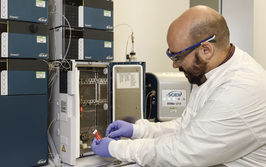
Tax Credits: Your Work is Worth it
Research and development tax reliefs are available for businesses in many countries, but some companies consider the area to be too complex and daunting and, in some cases, are too humble about their innovative projects.
Peter Beavis |

Many governments around the world offer corporate tax credits and other incentives for businesses – particularly those doing innovative research. The pharmaceutical industry conducts substantial R&D to develop the medicines of today and tomorrow, and the sector is in the top three in terms of intensity of innovation. However, it’s not uncommon for smaller companies in the pharma field to believe that handling and understanding incentives is best left to the big fish in the industry or those with financial backgrounds. Anyone involved in manufacturing medicines and other associated products should consider R&D tax incentives as a means to help grow their business and become more competitive.
In the UK, there are three main ways that the government provides support to the pharmaceutical industry: R&D tax credits, grants and patent box schemes. Other countries also offer similar incentives. My particular specialism is R&D tax credits within the pharmaceutical sector – and it’s something I’m passionate about because so many companies overlook them.
R&D tax credits are used to encourage companies to invest in innovation. This support helps bolster companies, encourage their growth and give them a competitive edge in the market. Governments want to invest in R&D because it’s good for the economy; in the UK, for example, the HMRC estimated that for every £1.00 awarded to an innovative company via R&D tax credits, up to £2.35 was stimulated in additional R&D expenditure. Why? Because businesses often spend the R&D tax credit benefit they receive on funding the next big push in their R&D work, which can involve hiring new skilled staff, expanding premises, or investing in new machinery. In turn, the host country’s economy benefits from the resulting increase in productivity.
In the UK, the SME R&D tax credit scheme allows companies to recoup up to £0.33 for every £1.00 spent on qualifying innovation. At £71,649, the average SME claim in pharma ranks significantly higher than the national average (£53,876). For example, if your medicines business is investing £500,000 in R&D each year, you could benefit from an R&D tax credit worth up to £166,750. And that’s just the beginning – I’ve seen claims of much more be successful!
R&D Rewards
Businesses of all sizes are typically eligible to claim R&D tax credits. In the UK, there are different types of tax relief depending on the size of the company, including a specific SME R&D relief for companies with fewer than 500 staff and either not more than €100 million turnover or €86 million gross assets. This is a pretty wide window, though SMEs will also need to consider linked companies and partnerships when working out their staff size, turnover and assets.
The most common objection I hear when talking to SMEs is: “My work doesn’t qualify as R&D.” The confusion is perhaps unsurprising given that the UK government’s definition of R&D is found in the Department for Business, Innovation & Skills (BIS) guidelines, which are an intimidating 17 pages long. The guidelines state, “R&D takes place when a project seeks to achieve an advance in science or technology through the resolution of scientific or technological uncertainty.” For some, this definition is intimidating, and for others it’s plain off-putting! But it is purposefully broad because it needs to apply equally to businesses from different sectors and of different sizes.
I find there are two questions that can help companies get to the heart of R&D:
- Are you creating a new product, process or service?
- Are you changing or modifying an existing product, process or service?
If the answer is yes, you should consider R&D tax credits. Essentially, if you’re not sure whether your project is possible, or you don’t know how to achieve it in practice, you could be resolving technological uncertainties and be carrying out qualifying R&D. And if you’ve taken a risk because your outcome was uncertain, this could be R&D too. Importantly, R&D doesn’t have to be successful to qualify.
Pharma is full of innovation and R&D. In drug development, for example, a company may be innovating in drug delivery or formulation technologies that control a drug’s release rate in the body. The development of new – or improved – coatings to prevent a drug from coming into contact with taste-buds, or the use of masking agents like flavorings and sweeteners can also qualify for tax R&D credits. The same goes for considerations relating to the shape and size of a drug, ensuring a medicine is easy to ingest and digest, while remaining effective for all patients, including children and those with disabilities. Even the non-active excipients in a product, such as binders and coatings, may require significant development to achieve the target rate of drug release and may qualify.
R&D can also encompass projects that are focused on the speed or efficiency of manufacturing. Creating an improved machinery process could qualify as R&D if, for example, it cooled something faster or used less electricity.
Innovation in pharma can also extend beyond the medicine and the processes used to make it. There is also the production of packaging; for example, precision sizing and shaping for compliance with measurement of drugs; dose-control modules for temperature control; tamper-resistant and childproof properties; security markings and anti-fraud elements to prove medicine is genuine. There’s R&D in the use of eco-friendly, sustainable packaging materials and ingredients, and packaging that bonds materials together in new ways. Additives that preserve shelf life may also be eligible.
Improving IT and software is another area where medicine businesses might be able to identify R&D; for example, a new IT application that must be integrated with a legacy system. On its own, the integration process wouldn’t necessarily qualify as R&D. But if the integration required some bespoke modification (usually by someone like a software developer) to overcome technological challenges, you may have the basis for a claim.
In summary, you should look at your activities and what you could potentially claim on. Don’t be put off thinking that the hassle is not worth the reward! My firm was recently involved in advising a pharma company on a successful R&D credit claim to the tune of £515,000, which was based on the company’s work to deduce the formulation of a drug for gout. Routine analysis was not enough to create a generic version of the medicine, and the company had to overcome the challenge of commercially synthesizing the APIs in a cost-effective and reliable way.
Too many SMEs are not making use of this valuable relief: firstly, because they don’t realize they’re eligible and, secondly, because they don’t fully understand how much R&D credits can be worth. The power of this incentive is only realized when you start to think about how you could use the money to grow your business. Whether you want to take on more skilled professionals or invest in new equipment, the opportunities are endless. Ultimately, R&D tax credits provide cash that could spark your next big project or fund the final push in creating something remarkable.
Three Top Tips
Don’t make the mistake of thinking R&D only relates to new products, processes or services. Improving something that already exists can count too. For example, if you’re making it quicker or more cheaply.
Talking to a specialist early can help you maximize a future R&D tax credit claim. Consultants can help companies to implement light record-keeping processes to document their R&D.
You only have two years from the end of your accounting period to make a claim. After that, you’ve missed out on recouping money spent in that period. It pays to take action!
Further Information
For those of you outside of the UK interested in tax R&D credits, how do you go about researching potential tax credits in your own countries? Since R&D tax credits are official/government incentives, the best place to start researching is to begin with a search for that country’s official innovation web pages. Governments all over the world reward private sector business for investing in innovation and he likes of Australia, Canada, France, Ireland, the Netherlands, Spain, the US and the UK, among others, all offer R&D tax incentives. So it’s well worth the effort to look up what’s available to you wherever you are based. There are also expert companies that can help you to get a headstart. My company works in the UK, but we are part of the alliantgroup, which offers tax consulting services in the US.
Chemicals and materials specialist at ForrestBrown; and a chartered scientist.



















